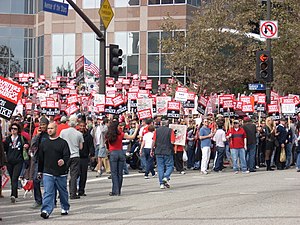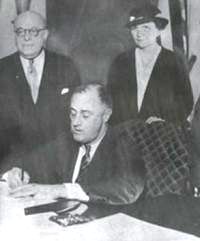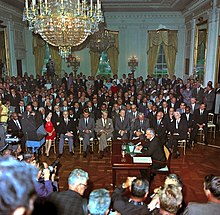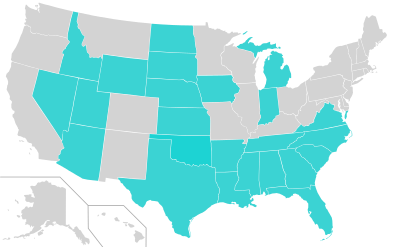United States labor law: Difference between revisions
Kriswarner (talk | contribs) m →Regulation of unions and organizing: tidying up language |
|||
| Line 20: | Line 20: | ||
{{Main|Norris-LaGuardia Act|National Labor Relations Act|Taft-Hartley Act|Labor Management Reporting and Disclosure Act}} |
{{Main|Norris-LaGuardia Act|National Labor Relations Act|Taft-Hartley Act|Labor Management Reporting and Disclosure Act}} |
||
{{See also|Labor unions in the United States}} |
{{See also|Labor unions in the United States}} |
||
[[Image:National Labor Relations Act2.jpg|right|thumb|President [[Franklin D. Roosevelt]] |
[[Image:National Labor Relations Act2.jpg|right|thumb|President [[Franklin D. Roosevelt]]]]Contrary to popular intent, the [[Sherman Antitrust Act]] (1890) led to [[prosecution]] of unions as illegal combinations, but Section 6 of the [[Clayton Antitrust Act]] (1914) ended this practice by stipulating that unions shall not be "construed to be illegal combinations or conspiracies in restraint of trade, under the antitrust laws." |
||
The [[National Labor Relations Act]] (NLRA, the "Wagner Act") gives private sector workers the right to choose whether they wish to be represented by a [[Trade union|union]] and establishes the [[National Labor Relations Board]] (NLRB) to hold elections for that purpose. As originally enacted in 1935, the NLRA makes it illegal for employers to discriminate against workers because of their union membership or retaliate against them for engaging in organizing campaigns or other "concerted activities", to form "company unions", or to refuse to engage in [[collective bargaining]] with the union that represents their employees. |
The [[National Labor Relations Act]] (NLRA, the "Wagner Act") gives private sector workers the right to choose whether they wish to be represented by a [[Trade union|union]] and establishes the [[National Labor Relations Board]] (NLRB) to hold elections for that purpose. As originally enacted in 1935, the NLRA makes it illegal for employers to discriminate against workers because of their union membership or retaliate against them for engaging in organizing campaigns or other "concerted activities", to form "company unions", or to refuse to engage in [[collective bargaining]] with the union that represents their employees. |
||
Revision as of 21:44, 7 January 2012

United States labor law is a heterogeneous collection of state and federal laws. Federal law not only sets the standards that govern workers' rights to organize in the private sector, but also overrides most state and local laws that attempt to regulate this area. Federal law also provides more limited rights for employees of the federal government. These federal laws do not apply to employees of state and local governments, agricultural workers or domestic employees; any statutory protections those workers have derived from state law.
The pattern is even more mixed in the area of wages and working conditions. Federal law establishes minimum wages and overtime rights for most workers in the private and public sectors; state and local laws may provide more expansive rights. Similarly, federal law provides minimum workplace safety standards, but allows the states to take over those responsibilities and to provide more stringent standards.
Finally, both federal and state laws protect workers from employment discrimination. In most areas these two bodies of law overlap; as an example, federal law permits states to enact their own statutes barring discrimination on the basis of race, gender, religion, national origin and age, so long as the state law does not provide less protections than federal law would. Federal law, on the other hand, preempts most state statutes that would bar employers from discriminating against employees to prevent them from obtaining pensions or other benefits or retaliating against them for asserting those rights.
The United States Congress has not ratified the International Labour Organization Convention on the Freedom of Association and Protection of the Right to Organise Convention, 1948 or the Right to Organise and Collective Bargaining Convention, 1949.
History
Employment law in the U.S. has traditionally been governed by the common law rule of "at-will employment," meaning that an employment relationship could be terminated by either party at any time without a reason. This is still true today in most states. However, starting in 1941, a series of laws prohibited certain discriminatory firings. That is, in most states, absent an express contractual provision to the contrary, an employer can still fire an employee for no or any reason, as long as it isn't an illegal reason (which includes a violation of public policy).
In 1941, Executive Order 8802 (or the Fair Employment Act) became the first law to prohibit racial discrimination, although it only applied to the national defense industry. Later laws include Title VII of the Civil Rights Act of 1964 (and amendments), Title I of the Americans with Disabilities Act of 1990,[1] the Family and Medical Leave Act of 1993,[2] and numerous state laws with additional protections. The Fair Labor Standards Act[3] regulates minimum wages and overtime pay for certain employees who work more than 40 hours in a work week. While working an employee must work a minimum of two hours in a day. Cases of employment discrimination in the United States are most often subject to the jurisdiction of the Equal Employment Opportunity Commission, the federal commission responsible for the enforcement of the anti-discrimination laws. Once a case has been filed with the EEOC or similar state agencies with concurrent jurisdiction, employees have a right to remove the case to the courts with the permission of the agency, or in some instances, after the expiration of a set time period. Employment law cases are heard in state or federal courts, depending upon the issue, the size of the employer (the Civil Rights Act of 1964,[4] for example, applies only to employers with 15 or more employees), and the litigation strategy of the plaintiff.
- Commonwealth v. Pullis (1806), establishing that unions were criminal conspiracies in the Philadelphia Mayor's court
- Commonwealth v. Hunt (1842), disapproving Pullis in the Massachusetts Supreme Judicial Court, and establishing that unions were not necessarily criminal
Regulation of unions and organizing

Contrary to popular intent, the Sherman Antitrust Act (1890) led to prosecution of unions as illegal combinations, but Section 6 of the Clayton Antitrust Act (1914) ended this practice by stipulating that unions shall not be "construed to be illegal combinations or conspiracies in restraint of trade, under the antitrust laws."
The National Labor Relations Act (NLRA, the "Wagner Act") gives private sector workers the right to choose whether they wish to be represented by a union and establishes the National Labor Relations Board (NLRB) to hold elections for that purpose. As originally enacted in 1935, the NLRA makes it illegal for employers to discriminate against workers because of their union membership or retaliate against them for engaging in organizing campaigns or other "concerted activities", to form "company unions", or to refuse to engage in collective bargaining with the union that represents their employees.
The Taft-Hartley Act (also the "Labor-Management Relations Act"), passed in 1947, loosened some of the restrictions on employers, changed NLRB election procedures, and added a number of new limitations on unions. The Act, among other things, prohibits jurisdictional strikes and secondary boycotts by unions, and authorizes individual states to pass "right-to-work laws", regulates pension and other benefit plans established by unions and provides that federal courts have jurisdiction to enforce collective bargaining agreements.
The United States Congress subsequently tightened those restrictions on unions in the Labor Management Reporting and Disclosure Act of 1959, which also regulates the internal affairs of all private sector unions, providing for minimum standards for unions' internal disciplinary proceedings, federal oversight for unions' elections of their own officers, and fiduciary standards for union officers' use of union funds. Congress has since expanded the NLRB's jurisdiction to health care institutions, with unique rules governing organizing and strikes against those employers.
The NLRA does not, on the other hand, cover governmental employees, with the exception of employees of the United States Postal Service, a quasi-public entity. The Federal Labor Relations Act provides for much more limited rights for employees of the federal government; Congress has, moreover, excluded a number of these workers in the United States Department of Homeland Security and elsewhere from even these limited protections.
Federal law does not provide employees of state and local governments with the right to organize or engage in union activities, except to the extent that the United States Constitution protects their rights to freedom of speech and freedom of association. The Constitution provides even less protection for governmental employees' right to engage in collective bargaining: while it bars public employers from retaliating against employees for forming a union, it does not require those employers to recognize that union, much less bargain with it.
Most states provide public employees with limited statutory protections; a few permit public employees to strike in support of their demands in some circumstances. Some states, however, particularly in the South, make it illegal for a governmental entity to enter into a collective bargaining agreement with a union.
The NLRA does not cover agricultural or domestic employees. A few states have enacted labor laws similar to the NLRA covering farm workers.
Finally, the NLRA does not cover employees in the railroad and airline industries. Those workers are covered by the Railway Labor Act, first passed in 1926, then amended in 1936 to cover airline employees. The RLA creates a wholly different structure for resolving labor disputes, requiring bargaining under indirect governmental supervision and permitting strikes only in limited circumstances.
The Norris-LaGuardia Act of 1932 outlawed the issuance of injunctions in labor disputes by federal courts. While the Act does not prevent state courts from issuing injunctions, it ended what some observers called "government by injunction", in which the federal courts used injunctions to prevent unions from striking, organizing and, in some cases, even talking to workers or entering certain parts of a state. Roughly half the states have enacted their own version of the Norris-LaGuardia Act.
For the most part the NLRA and RLA displace state laws that attempt to regulate the right to organize, to strike and to engage in collective bargaining. The NLRB has exclusive jurisdiction to determine whether an employer has engaged in an unfair labor practice and to decide what remedies should be provided. States and local governments can, on the other hand, impose requirements when acting as market participants, such as requiring that all contractors sign a project labor agreement to avoid strikes when building a public works project, that they could not if they were attempting to regulate those employers' labor relations directly.
- NLRB v. Mackay Radio & Telegraph Co. 304 U.S. 333 (1938), that striking workers remain "employees"
- United States v. Congress of Industrial Organizations, 335 U.S. 106 (1948), holding that unions advocating members vote for particular Congress candidates did not violate the Federal Corrupt Practices Act as amended by the Labor Management Relations Act
Regulation of wages, benefits and working conditions

The Fair Labor Standards Act[5] of 1938 (FLSA) establishes minimum wage and overtime rights for most private sector workers, with a number of exemptions and exceptions. Congress amended the Act in 1974 to cover governmental employees, leading to a series of United States Supreme Court decisions in which the Court first held that the law was unconstitutional, then reversed itself to permit the FLSA to cover governmental employees.
The FLSA does not preempt state and local governments from providing greater protections under their own laws. A number of states have enacted higher minimum wages and extended their laws to cover workers who are excluded under the FLSA or to provide rights that federal law ignores. Local governments have also adopted a number of "living wage" laws that require those employers that contract with them to pay higher minimum wages and benefits to their employees. The federal government, along with many state governments, likewise require employers to pay the prevailing wage, which typically reflects the standards established by unions' collective bargaining agreements in the area, to workers on public works projects.
The Employee Retirement Income Security Act[6] establishes standards for the funding and operation of pension and health care plans provided by employers to their employees. The ERISA preempts most state legislation that attempts to regulate how such plans are administered and, to a great extent, what types of health care coverage they provide. ERISA also preempts state law claims that an employer discriminated against employees in order to prevent them from obtaining the benefits they would have earned otherwise or to retaliate against them for asserting their rights.
The Family and Medical Leave Act,[7] passed in 1993, requires employers to provide workers with twelve weeks of unpaid medical leave and continuing medical benefit coverage in order to attend to certain medical conditions of close relatives or themselves. Many states have comparable statutory provisions; some states have offered greater protections.
The Occupational Safety and Health Act,[8] signed into law in 1970 by President Richard Nixon, creates specific standards for workplace safety. The Act has spawned years of litigation by industry groups that have challenged the standards limiting the amount of permitted exposure to chemicals such as benzene. The Act also provides for protection for "whistleblowers" who complain to governmental authorities about unsafe conditions while allowing workers the right to refuse to work under unsafe conditions in certain circumstances. The Act allows states to take over the administration of OSHA in their jurisdictions, so long as they adopt state laws at least as protective of workers' rights as under federal law. More than half of the states have done so.
Employment discrimination and whistleblowers

While Congress passed laws barring racial discrimination by private employers in 1866 with the Civil Rights Act of 1866,[9] the Supreme Court's decision in the Civil Rights Cases made that Act a dead letter for nearly a century. Congress adopted limited prohibitions against racial discrimination by defense contractors during World War II, but no general prohibition against employment discrimination until it passed Title VII of the Civil Rights Act of 1964,[10] which bars employment discrimination on the basis of race, gender, national origin and religion. Congress amended that Act in 1972 to cover governmental employers, in 1981 to outlaw employment discrimination on the basis of pregnancy, and again in the Civil Rights Act of 1991 to overturn a number of decisions by the Supreme Court limiting employees' rights.
Congress has also protected the rights of workers over forty years of age in the Age Discrimination in Employment Act, passed in 1967, and the Americans with Disabilities Act[11] of 1990. The Immigration Reform and Control Act of 1986 also provides narrow prohibitions against certain types of employment discrimination based on immigration status.
Title VII[12] encourages states to pass their own anti-discrimination laws; most states outside the South have done so. A number of states and local governments have also enacted statutes that expand on the rights that federal law offers, either by offering greater remedies or broader protections, or have legislated in areas that federal law does not cover, such as discrimination based on sexual orientation or marital status.
The states and the federal government have also enacted a welter of laws to protect whistleblowers; these statutes vary widely in what conduct is protected, what procedures must be followed to enforce the law and what remedies are provided. Public sector employees are also protected from retaliation by their employers for some forms of whistleblowing activities by the First Amendment to the United States Constitution.[13]
Job security
While most state and federal laws start from the presumption that workers who are not covered by a collective bargaining agreement or an individual employment agreement are "at will" employees who can be fired without notice and for no stated reason, state and federal laws prohibiting discrimination or protecting the right to organize or engage in whistleblowing activities modify that rule by providing that discharge or other forms of discrimination are illegal if undertaken on grounds specifically prohibited by law. In addition, a number of states have modified the general rule that employment is at will by holding that employees may, under that state's common law, have implied contract rights to fair treatment by their employers. US private-sector employees thus do not have the indefinite contracts (similar to US academic tenure) traditionally common in many European countries, Canada and New Zealand.
Public employees in both federal and state government are also typically covered by civil service systems that protect them from unjust discharge. Public employees who have enough rights against unjustified discharge by their employers may also acquire a property right in their jobs, which entitles them in turn to additional protections under the due process clause of the Fourteenth Amendment to the United States Constitution.[14]
The Worker Adjustment and Retraining Notification Act, better known by its acronym as the WARN Act, requires private sector employers to give sixty days' notice of large-scale layoffs and plant closures; it allows a number of exceptions for unforeseen emergencies and other cases. Several states have adopted more stringent requirements of their own.
Labor law in individual states
Right-to-work laws

The following 22 states are right-to-work states:
- Alabama
- Arizona †
- Arkansas †
- Florida †
- Georgia
- Idaho
- Iowa
- Kansas
- Louisiana
- Mississippi †
- Nebraska
- Nevada
- North Carolina
- North Dakota
- Oklahoma †
- South Carolina
- South Dakota
- Tennessee
- Texas
- Utah
- Virginia
- Wyoming
In addition, the territory of Guam also has right-to-work laws.
† An employee's right-to-work is established under the state Constitution, not under legislative action.
Constitutional amendments
In 2010, the organization Save Our Secret Ballot pushed four states: Arizona, South Carolina, South Dakota, and Utah to pass constitutional amendments to ban Card check.
California
In 1959, California added the Division of Fair Employment Practices to the California Department of Industrial Relations. The Fair Employment and Housing Act[15] of 1980 gave the division its own Department of Fair Employment and Housing, with the stated purpose of protecting citizens against harassment and employment discrimination on the basis of:[16] age, ancestry, color, creed, denial of family and medical care leave, disability (including HIV/AIDS), marital status, medical condition, national origin, race, religion, sex, transgender and orientation. Sexual orientation was not specifically included in the original law but precedent was established based on case law. On October 9, 2011, California Governor Edmund G. "Jerry" Brown signed into law Assembly Bill No. 887 alters the meaning of gender for the purposes of discrimination laws that define sex as including gender so that California law now prohibits discrimination on the basis of gender identity and gender expression.[17]
The state also has its own labor law covering agricultural workers, the California Agricultural Labor Relations Act.
See also
- Agricultural Labor Relations Act
- At-will employment
- Child labor laws in the United States
- Labor federation competition in the U.S.
- Labor law
- List of U.S. minimum wages
- UK labour law
- Journals
- Organizations
- American Rights at Work, a charity supporting union rights
- Congress of Industrial Organizations
- International Society for Labor Law and Social Security
- National Labor Federation, an organization supporting workers outside the protection of federal labor laws
- United States Department of Labor, includes a list of labor legislation
Notes
- ^ Finduslaw.com
- ^ Finduslaw.com
- ^ Finduslaw.com
- ^ Finduslaw.com
- ^ Text of the Fair Labor Standards Act
- ^ Text of the Employee Retirement Income Security Act
- ^ Text of the Family and Medical Leave Act
- ^ Text of the Occupational Safety and Health Act
- ^ Finduslaw.com
- ^ Finduslaw.com
- ^ Finduslaw.com
- ^ Finduslaw.com
- ^ Finduslaw.com
- ^ Finduslaw.com
- ^ The Fair Employment and Housing Act
- ^ Details of law from the DFEH website
- ^ Barnes & Thornburg LLP (October 12, 2011). "California Enacts 22 New Employment Laws Impacting All Companies Doing Business In The State". The National Law Review.
